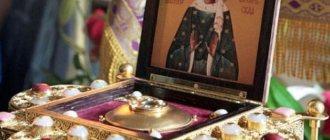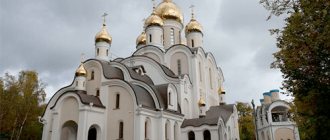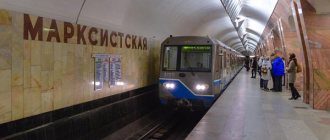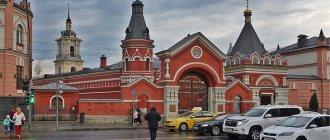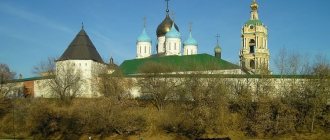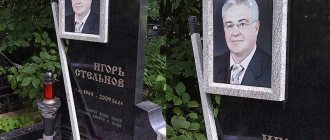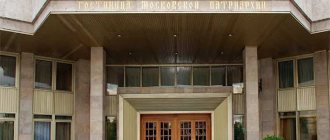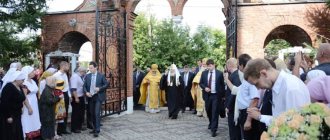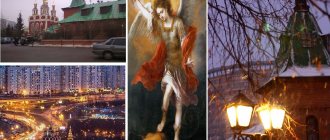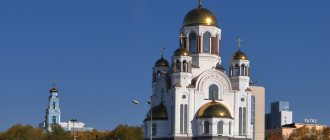Location of the temple with the relics of St. Matrona in Moscow. The healing power of the water collected in this temple.
People are naturally inclined to believe. Although history tells us about different periods when the authorities limited and sought to eradicate faith from human hearts, it, like a spring, was revived again.
Each religious direction has its own holy personalities, who with their lives taught people to live according to God’s law. One of them is Saint Matrona of Moscow.
As during her life, the flow of people to her does not dry up, bringing their troubles, illnesses, mental discord and questions. And she will listen to everyone and give a hint on what to do.
Let's talk in more detail about the place where the saint's relics are stored, the temple's work schedule and the properties of the water from the holy source of the monastery where they are located.
In which temple are the relics of the Holy Blessed Matrona?
shrine with the relics of Saint Matrona and her icon.
The relics of the Holy Blessed Matrona rest in the Church of the Intercession of the Blessed Virgin Mary, located on the territory of the Intercession Stauropegic Women's Monastery. They were moved here in March 1998.
Until this date, the relics were located at the Danilovsky cemetery. Here, the saint’s grave was decorated with fresh flowers all year round and there was a long line of people who came for spiritual help and instructions from different parts of Russia and abroad.
To strengthen the Orthodox in the faith, the church fathers organized the storage and travel of individual parts of holy relics to other churches in Moscow and throughout the country. Therefore, more people can venerate the miraculous remains and sincerely turn in prayer to the Lord and Matrona.
Modern life of the monastery
Now the monastery is stauropegial, that is, it reports directly to the Patriarch.
Abbess and sisters
Abbess Feofania (Miskina)
Since February 22, 1995, the sisters have been headed by Abbess Feofaniya (Miskina). Mother took monastic vows in 1990, and was tonsured into the mantle on April 14, 1995 by Patriarch Alexy II. The abbess managed to revive monastic life and restore churches.
It all started in October 1995, when the first liturgy took place in the dilapidated Church of the Intercession. Then the number of nuns, together with the abbess, was only 5. And the temporary iconostasis was built from plywood by mother’s brother, Alexander.
By 2014, there were 50 sisters. On the Internet page and in the churches of the monastery you can see an announcement that Pokrovsky invites both working women who want to work for the glory of God, and sisters “who want to devote their lives to God, from 18 to 60 years old.”
Now the monastery operates:
- Orthodox gymnasium at the Trinity-Lykovo courtyard;
- a shelter for girls from single-parent, disadvantaged families (since 2004);
- publishing house
Where is the Church of St. Matrona of Moscow located?
photo of the Pokrovsky Convent in Moscow, on the territory of which the relics of St. Matrona are buried in the temple.
The temple with the relics of St. Matrona is located in Moscow on the territory of the Intercession Convent.
Service schedule, operating hours
The Church of the Matrona of Moscow on Taganka receives pilgrims and parishioners every day from Monday to Saturday from 7.00 to 20.00, on Sunday from 6.00 to 20.00.
Schedule of daily Liturgies:
| Days of the week | Morning | Evening |
| Weekdays (except church holidays) | 7.30 | 16.30 or 16.45 |
| Saturday | 7.30 | All-night vigil from 16.45 |
| Sunday | 6.15, 9.00 | 16.00 or 16.45 |
Church of St. Matrona of Moscow in Moscow on Taganka: address, metro, map
The temple with the relics of St. Matrona is located in Moscow at the address: Taganskaya St., 58.
Nearest metro stations:
- Proletarskaya
- Peasant outpost
- Marxist
- Taganskaya
To make it easier to perceive the location of the Intercession Monastery, we add a map:
location of the Intercession Convent in Moscow on the map
Church of St. Matrona in Moscow on Taganka: how to get there?
photo of the temple in which the relics of St. Matrona rest.
The most convenient form of transport in any city is the metro. Therefore, in Moscow, get in it and go to any of the stations indicated in the section above.
Your further route looks like this. For example, from the Taganskaya metro station:
- exit the station to the right
- focus on McDonald's and walk along the pedestrian crossings so that it is on your left
- further along Taganskaya Street you go straight to the stone fence of the Pokrovsky Convent
From metro station "Marksistskaya":
- leaving the station, you will find yourself in an underground passage
- turn left and go up,
- in front of you will be McDonald's, and on the right is Tagansky Passage,
- turn right, then the passage will be to the left of your direction of travel,
- then either take public transport and go 3 stops to the monastery, or see a private taxi driver, or walk. If you decide to take a bus/trolleybus, then get off at the Bolshaya Andronevskaya stop, it will be the third one,
- after a 10-15 minute walk you will be greeted by the walls of the monastery. They will be on your right
- turn into the first gate, on the wall you will see a sign with the address “Taganskaya St., 58”.
From the metro station “Krestyanskaya Zastava” or “Proletarskaya”:
- go out to Krestyanskaya Zastava Square and go straight to the big intersection
- continue in the direction of your movement after crossing roads
- you get to Abelmanovskaya street
- on your left side you will soon see the red brick walls of the monastery
- walking time from the metro - 10 minutes
Water from the Church of St. Matrona: properties
holy spring on the territory of the Intercession Convent in Moscow
As Saint Matrona said during her lifetime, consecrated water, like communion, has enormous power and benefits the soul and body.
Considering that the Intercession Monastery is a place of prayer, where services and prayer services for parishioners are regularly held to this day, the water in it acquires the power of Epiphany.
And its properties are as follows:
- heals physical ailments, pain, mental disorders
- cleanses the body and spirit from the influences of dark forces
- illuminates housing, cars, clothes, animals if sprinkled with them
- transmits its power, changes the structure of ordinary water when mixed
- enhance the effect of medications
- washes away the consequences of intense communication, stress, unpleasant glances from others
- energizes you for the whole day after regular morning ablutions
In order for the water from the Church of St. Matrona to retain its qualities, store it behind household icons and regularly use it with prayer addressed to God and Matrona.
So, we found out the address of the Church of St. Motrona of Moscow, how to get to it, as well as the schedule of work and prayer services.
However, only your sincere faith in help from higher powers and saints, as well as specific regular actions, can create a real miracle in your life.
Believe and go to holy persons for instructions and help!
History of the monastery
The monastery began its life in the 17th century. like a man's.
"Bozhedomye"
The place where it was built has long been called “Wretched Houses”, or “poor house”. In Christian Rus', following the example of Jerusalem, where there was “land for the burial of strange people,” that is, Jews who came from other places and were caught in the Holy City by a sudden death. Such a death was considered a bad sign, perhaps indicating the secret sins of the deceased. But, by the providence of God, just such a plot was bought from the potter by the Jewish high priests with 30 silver coins, which were returned to them by the disciple-traitor of Jesus Christ, Judas, overcome by despair from his act.
It is on this basis that a kind of cemeteries for the burial of the “rootless” in Rus' also began to be called the Houses of God, or “God’s House”. Didn’t Christ Himself walk as a stranger, without permanent residence, persecuted by everyone? Is it not He who receives the restless souls of those who suffered during earthly life? This was the significance of this place. There was a parish church of the Intercession of the Virgin Mary here - small, wooden. Here, famous and unknown servants of God were commemorated here unacceptably.
Base
On October 14, 1633, on the Intercession of the Most Holy Theotokos, Patriarch Filaret (in the world boyar Fyodor Nikitich Romanov), father of Sovereign Mikhail Feodorovich, reposed. After 2 years, the son, as a memory of his deceased parent-archpastor, decided to build a monastic monastery at the “Bozhedomye”. The choice, obviously, was connected with the dedication of the local church to the Intercession, and also with the fact that the intense prayer of the monks for those who rest here, of course, will give joy to the soul of the deceased Primate, to whose memory the monastery will be dedicated.
The king had just begun to build the monastery, and it was already completed by the patriarch’s grandson. Filareta, Alexey Mikhailovich. Funds for construction were obtained from the government leasing land for the construction of houses. That is why the monastery was called by the townspeople not only “Bozhedomskaya”, but also “room”.
From the “attached” monastery to the missionary center
By 1655, it was possible to rebuild the Church of the Intercession in stone. Gradually the brethren gathered. The name of the possible first abbot, Stefan, who previously served at the Annunciation Cathedral of the Kremlin, has been preserved. A special task of the monks was to commemorate all the dead buried on this land.
However, the monastery, apparently, was never particularly rich or prosperous; the monks lived modestly, and perhaps even poorly. Already by 1680, Pokrovsky was made “assigned” to the Zaikonospassky Monastery of the capital. It remained such until 1731. Then, in accordance with the then state policy, which since the time of Peter I had demanded “public benefit” from the monks, they tried to make the monastery a “school.” He was given independence by opening a seminary here. For the 1730s - 1770s. erected:
- the second stone temple of the Renewal of the Temple of the Resurrection of Christ in Jerusalem (the so-called Resurrection of the Word);
- a stone bell tower.
As for the seminary, it was closed over time, distributing the students to other theological schools. According to the “monastic states” introduced by Catherine II (1764), Pokrovsky was classified as “third class,” which meant a symbolic annual subsidy from the Synod of 300 rubles. At the same time, like other monasteries, all lands were completely taken away, so the situation of the monks for a long time was practically disastrous.
The already poor monastery experienced the invasion of Napoleon's troops especially hard - occupation troops were stationed on its territory, the French desecrated churches and took away shrines. Only by 1855 was it possible to restore the Church of the Resurrection of the Word and rebuild the stone walls.
New life was breathed into the monastery by the project of St. Innocent (Veniaminov), Metropolitan of Moscow. Vladyka decided to make Pokrovsky a missionary one. Since 1870, a school has been opened here for monastics who want to bring the Word of God to the pagans of the North, Siberia, Alaska, and China. However, work continued only until 1879, until the death of the archpastor.
Cemetery
Despite the very ambiguous attitude of the secular authorities towards the monastery, ordinary Muscovites loved it, revered the shrines, and many, including famous residents of the capital, wanted to be buried near the place where they had been praying for the dead for centuries.
The cemetery at Pokrovsky was the largest of the monastic necropolises of the capital, it occupied more than 5 hectares.
For example, here rest:
- many of the representatives of the famous Moscow Botkin family - for example, literary critic Vasily Petrovich Botkin, Dmitry Petrovich - collector, entrepreneur, others;
- local historian Nikolai Naydenov, publisher of albums about the capital's churches;
- missionary, creator of a grammar of the Yakut language, Bishop Dionysius (Khitrov), many other famous and unknown Muscovites.
Timelessness
After the arrival of Soviet power, the monastery continued to operate for some time. Its churches were closed only in 1926, after which the bell tower was demonstratively blown up.
It is known that the last governor of Pokrovsky before his liquidation by the Soviet authorities was Archimandrite Veniamin (Milov). He took monastic vows after the revolution, in 1920, knowing full well what he was dooming himself to. He was arrested in October 1929, and then the monastery was finally closed.
In anticipation of the inevitable arrest, Fr. Benjamin wrote memoirs entitled “The Diary of a Monk.” He writes with humility about what is happening: “I thank God... The Lord taught me, a sybarite and lover of a quiet life, to endure cramped conditions, inconveniences, sleepless nights, cold, loneliness, and showed the extent of human suffering.”
Many monks were expected to receive crowns of martyrdom, but the Lord judged Father Archimandrite to perform the feat of confession. In total, he was arrested three times, the last time in 1949. He went through camps and exile. And on February 1, 1955, he became the bishop of Saratov and Balashov, but this, already the last obedience, lasted less than a year - on August 2, 1955, the bishop died. He has not yet been canonized, although many Orthodox believers are confident that the confessor is a saint. A record of miracles through prayers to him is being kept, and on July 8, 2016, the flow of myrrh from the cross on the grave was witnessed.
As for the monastery itself, its territory was occupied by Soviet institutions. By 1992, there were up to forty of them here. The greatest pain was caused to believers by the systematic destruction of the necropolis in the 1930s. A “recreation park” was set up in its place. Subsequently, the “petrified insensitivity” of many city residents who grew up under the Soviet system would reach the point that in the 2000s. A whole social movement will begin against the transfer of Tagansky Park, a “recreation place” to the monastery. In 2009, the authorities refused this due to... “lack of legal grounds.”
New life
It began on November 24, 1994, when a decision was made to resume monastic life at the holy place. But the monastery was revived as a convent.
